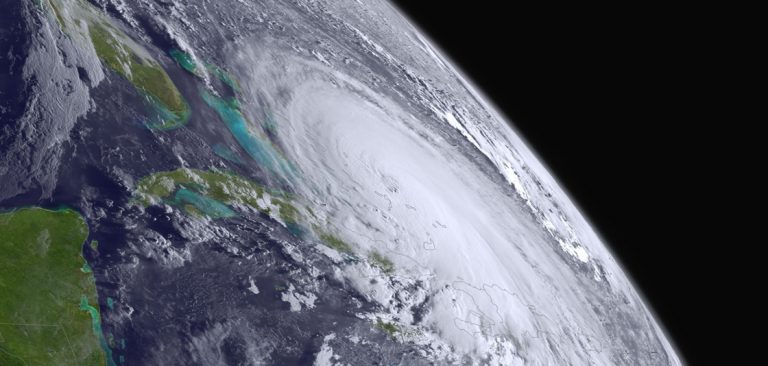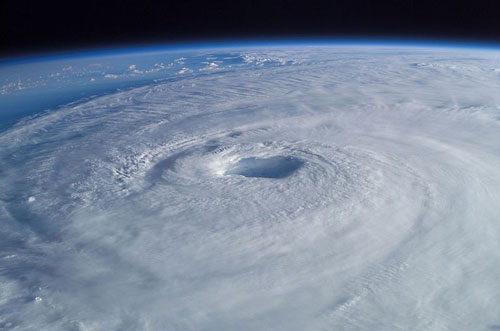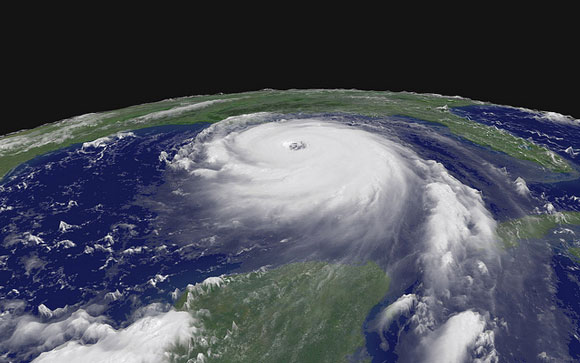
The Atlantic hurricane season begins on June 1 and ends November 30.
Ever wonder how hurricanes get their names? And why do hurricanes have names at all? Meteorologists long ago learned that naming tropical storms and hurricanes helps people remember the storms, communicate about them more effectively, and so stay safer if and when a particular storm strikes a coast. These experts assign names to hurricanes according to a formal list of names that is approved prior to the start of each hurricane season. The U.S. National Hurricane Center started this practice in 1950. Now, the World Meteorological Organization generates and maintains the list of hurricane names.
Here are the hurricane names for 2018:
Atlantic hurricane names are: Alberto, Beryl, Chris, Debby, Ernesto, Florence, Gordon, Helene, Isaac, Joyce, Kirk, Leslie, Michael, Nadine, Oscar, Patty, Rafael, Sara, Tony, Valerie, William. The Atlantic hurricane season runs from June 1 to November 30.
Eastern North Pacific hurricane names are: Aletta, Bud, Carlotta, Daniel, Emilia, Fabio, Gilma, Hector, Ileana, John, Kristy, Lane, Miriam, Norman, Olivia, Paul, Rosa, Sergio, Tara, Vicente, Willa, Xavier, Yolanda, Zeke. The eastern North Pacific hurricane season runs from May 15 to November 30.
If you’re interested, you can view those names, and names for upcoming years, here.

Astronaut Ed Lu captured this view of Hurricane Isabel in 2003 from the International Space Station. Image via Mike Trenchard, NASA.
How and why did hurricanes first begin receiving names? While people have been naming major storms for hundreds of years, most hurricanes were originally designated by a system of latitude-longitude numbers, which was useful to meteorologists trying to track these storms. Unfortunately, this system was confusing to people living on coasts seeking hurricane information.
In 1950, a formal practice for storm naming was first developed for the Atlantic Ocean by the U.S. National Hurricane Center. At that time, storms were named according to a phonetic alphabet (e.g., Able, Baker, Charlie) and the names used were the same for each hurricane season; in other words, the first hurricane of a season was always named “Able,” the second “Baker,” and so on.
In 1953, to avoid the repetitive use of names, the system was revised so that storms would be given female names. By doing this, the National Weather Service was mimicking the habit of naval meteorologists, who named the storms after women, much as ships at sea were traditionally named for women.
In 1979, the system was revised again to include both female and male hurricane names.
See the complete history of naming hurricanes, from NOAA
Hurricane Alex as seen on January 14, 2016, by the the Moderate Resolution Imaging Spectroradiometer (MODIS) on NASA’s Terra satellite. Image via NASA Earth Observatory.
When does a storm receive a name? Tropical storms are given names when they display a rotating circulation pattern and wind speeds of 39 miles per hour (63 kilometers per hour). A tropical storm develops into a hurricane when wind speeds reach 74 mph (119 kph).
Lists of hurricane names have been developed for many of the major ocean basins around the world. Today, there are six lists of hurricane names in use for Atlantic Ocean storms. These lists rotate, one each year. That means the list of this year’s hurricane names will come up again six years from now. There’s an exception to this practice, however. The names of hurricanes that are particularly damaging are retired for legal and historical reasons. For example, the use of the name Katrina was retired in 2005 following the devastating impact that Hurricane Katrina had on New Orleans. Likewise, the use of the name Harvey was retired in 2017 following the damaging floods that Hurricane Harvey caused in the Houston metropolitan area.

Hurricane Katrina on August 28, 2005. Image via NASA.
Bottom line: Hurricanes are given names according to a formal system that is managed by the World Meteorological Organization. Hurricane names for 2018 are listed here.
from EarthSky https://ift.tt/1kHu4LC

The Atlantic hurricane season begins on June 1 and ends November 30.
Ever wonder how hurricanes get their names? And why do hurricanes have names at all? Meteorologists long ago learned that naming tropical storms and hurricanes helps people remember the storms, communicate about them more effectively, and so stay safer if and when a particular storm strikes a coast. These experts assign names to hurricanes according to a formal list of names that is approved prior to the start of each hurricane season. The U.S. National Hurricane Center started this practice in 1950. Now, the World Meteorological Organization generates and maintains the list of hurricane names.
Here are the hurricane names for 2018:
Atlantic hurricane names are: Alberto, Beryl, Chris, Debby, Ernesto, Florence, Gordon, Helene, Isaac, Joyce, Kirk, Leslie, Michael, Nadine, Oscar, Patty, Rafael, Sara, Tony, Valerie, William. The Atlantic hurricane season runs from June 1 to November 30.
Eastern North Pacific hurricane names are: Aletta, Bud, Carlotta, Daniel, Emilia, Fabio, Gilma, Hector, Ileana, John, Kristy, Lane, Miriam, Norman, Olivia, Paul, Rosa, Sergio, Tara, Vicente, Willa, Xavier, Yolanda, Zeke. The eastern North Pacific hurricane season runs from May 15 to November 30.
If you’re interested, you can view those names, and names for upcoming years, here.

Astronaut Ed Lu captured this view of Hurricane Isabel in 2003 from the International Space Station. Image via Mike Trenchard, NASA.
How and why did hurricanes first begin receiving names? While people have been naming major storms for hundreds of years, most hurricanes were originally designated by a system of latitude-longitude numbers, which was useful to meteorologists trying to track these storms. Unfortunately, this system was confusing to people living on coasts seeking hurricane information.
In 1950, a formal practice for storm naming was first developed for the Atlantic Ocean by the U.S. National Hurricane Center. At that time, storms were named according to a phonetic alphabet (e.g., Able, Baker, Charlie) and the names used were the same for each hurricane season; in other words, the first hurricane of a season was always named “Able,” the second “Baker,” and so on.
In 1953, to avoid the repetitive use of names, the system was revised so that storms would be given female names. By doing this, the National Weather Service was mimicking the habit of naval meteorologists, who named the storms after women, much as ships at sea were traditionally named for women.
In 1979, the system was revised again to include both female and male hurricane names.
See the complete history of naming hurricanes, from NOAA
Hurricane Alex as seen on January 14, 2016, by the the Moderate Resolution Imaging Spectroradiometer (MODIS) on NASA’s Terra satellite. Image via NASA Earth Observatory.
When does a storm receive a name? Tropical storms are given names when they display a rotating circulation pattern and wind speeds of 39 miles per hour (63 kilometers per hour). A tropical storm develops into a hurricane when wind speeds reach 74 mph (119 kph).
Lists of hurricane names have been developed for many of the major ocean basins around the world. Today, there are six lists of hurricane names in use for Atlantic Ocean storms. These lists rotate, one each year. That means the list of this year’s hurricane names will come up again six years from now. There’s an exception to this practice, however. The names of hurricanes that are particularly damaging are retired for legal and historical reasons. For example, the use of the name Katrina was retired in 2005 following the devastating impact that Hurricane Katrina had on New Orleans. Likewise, the use of the name Harvey was retired in 2017 following the damaging floods that Hurricane Harvey caused in the Houston metropolitan area.

Hurricane Katrina on August 28, 2005. Image via NASA.
Bottom line: Hurricanes are given names according to a formal system that is managed by the World Meteorological Organization. Hurricane names for 2018 are listed here.
from EarthSky https://ift.tt/1kHu4LC

Aucun commentaire:
Enregistrer un commentaire